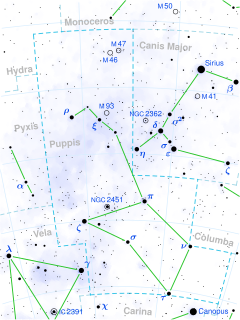| Observation data Epoch J2000 Equinox J2000 | |
|---|---|
| Constellation | Puppis |
| Right ascension | 08h 03m 35.1s[1] |
| Declination | −40° 00′ 11.6″[1] |
| Apparent magnitude (V) | 2.24 - 2.26[2] |
| Characteristics | |
| Evolutionary stage | Blue supergiant |
| Spectral type | O4If(n)p[3] |
| U−B color index | −1.09[4] |
| B−V color index | −0.27[4] |
| Variable type | rotating?[2] |
| Astrometry | |
| Proper motion (μ) | RA: −27.91[1] mas/yr Dec.: 16.68[1] mas/yr |
| Parallax (π) | 3.01 ± 0.10 mas[1] |
| Distance | 1,080 ± 40 ly (330 ± 10 pc) |
| Absolute magnitude (MV) | −6.23[5] |
| Details | |
| Mass | 25.3 to 42.4[6] M☉ |
| Radius | 13.5±0.2[6] R☉ |
| Luminosity (bolometric) | 446,700+66,200 −57,600[6] – 813,000[5] L☉ |
| Surface gravity (log g) | 3.9[7] cgs |
| Temperature | 40,000[5] K |
| Metallicity [Fe/H] | 0.34[8] dex |
| Rotation | 1.78 days[9] |
| Rotational velocity (v sin i) | >220[8] km/s |
| Age | 2.2+0.6 −0.5 to 3.56+0.77 −0.75[6] Myr |
| Other designations | |
| Database references | |
| SIMBAD | data |
Zeta Puppis (ζ Puppis, abbreviated Zeta Pup, ζ Pup), formally named Naos /naʊs/,[11] is the brightest star in the constellation of Puppis.
The spectral class of O4 means this is one of the hottest, and most luminous, stars visible to the naked eye. It is one of the sky's few naked-eye class O-type stars as well as one of the closest to Earth.[12] It is a blue supergiant, one of the most luminous stars in the Milky Way. Visually it is over 10,000 times brighter than the Sun, but its high temperature means that most of its radiation is in the ultraviolet and its bolometric luminosity is over 500,000 times that of the Sun. It is also the 72nd brightest star in terms of apparent magnitude from Earth. It is a runaway star, meaning it has an unusually large space velocity, probably caused by being ejected from a close binary system when its companion exploded as a supernova.
Zeta Puppis is typical of O-type stars in having an extremely strong stellar wind, measured at 2,500 km/s,[13] which sees the star shed more than a millionth of its mass each year,[13] or about 10 million times that shed by the Sun over a comparable time period.
- ^ a b c d e Van Leeuwen, F. (2007). "Validation of the new Hipparcos reduction". Astronomy and Astrophysics. 474 (2): 653–664. arXiv:0708.1752. Bibcode:2007A&A...474..653V. doi:10.1051/0004-6361:20078357. S2CID 18759600.
- ^ a b "zeta Pup". International Variable Star Index. AAVSO. Retrieved 2022-06-15.
- ^ Sota, A.; Maíz Apellániz, J.; Walborn, N. R.; Alfaro, E. J.; Barbá, R. H.; Morrell, N. I.; Gamen, R. C.; Arias, J. I. (2011). "The Galactic O-Star Spectroscopic Survey. I. Classification System and Bright Northern Stars in the Blue-Violet at R ∼ 2500". The Astrophysical Journal Supplement Series. 193 (2): 24–50. arXiv:1101.4002. Bibcode:2011ApJS..193...24S. doi:10.1088/0067-0049/193/2/24. S2CID 119248206.
- ^ a b Ducati, J. R. (2002). "VizieR On-line Data Catalog: Catalogue of Stellar Photometry in Johnson's 11-color system". CDS/ADC Collection of Electronic Catalogues. 2237: 0. Bibcode:2002yCat.2237....0D.
- ^ a b c Bouret, J. -C.; Hillier, D. J.; Lanz, T.; Fullerton, A. W. (2012). "Properties of Galactic early-type O-supergiants: A combined FUV-UV and optical analysis". Astronomy & Astrophysics. 544: A67. arXiv:1205.3075v1. Bibcode:2012A&A...544A..67B. doi:10.1051/0004-6361/201118594. S2CID 119280104.
- ^ a b c d Cite error: The named reference
howarth2019was invoked but never defined (see the help page). - ^ Cite error: The named reference
markovawas invoked but never defined (see the help page). - ^ a b Dany Vanbeveren (2011). "Zeta Pup: The merger of at least two massive stars". Proceedings of a Scientific Meeting in Honor of Anthony F. J. Moffat Held at Auberge du Lac Taureau. 465: 342. arXiv:1109.6497v1. Bibcode:2012ASPC..465..342V.
- ^ Nichols, Joy S.; Nazé, Yaël; Huenemoerder, David P.; Moffat, Anthony F. J.; Miller, Nathan A.; Lauer, Jennifer; Ignace, Richard; Gayley, Ken; Ramiaramanantsoa, Tahina; Oskinova, Lidia; Hamann, Wolf-Rainer; Richardson, Noel D.; Waldron, Wayne L.; Dahmer, Matthew (2021). "Correlated X-Ray and Optical Variability in the O-type Supergiant ζ Puppis". The Astrophysical Journal. 906 (2): 89. arXiv:2011.07066. Bibcode:2021ApJ...906...89N. doi:10.3847/1538-4357/abca3a. S2CID 226955884.
- ^ Hoffleit, Dorrit; Jaschek, Carlos (1991). "The Bright star catalogue". New Haven. Bibcode:1991bsc..book.....H.
- ^ "IAU Catalog of Star Names". Retrieved 28 July 2016.
- ^ Schilbach, E.; Röser, S. (2008). "On the origin of field O-type stars". Astronomy and Astrophysics. 489 (1): 105–114. arXiv:0806.0762. Bibcode:2008A&A...489..105S. doi:10.1051/0004-6361:200809936. S2CID 18791701.
- ^ a b Eversberg, T.; Lepine, S.; Moffat, A. F. J. (1998). "Outmoving Clumps in the Wind of the Hot O Supergiant ζ Puppis". The Astrophysical Journal. 494 (2): 799. Bibcode:1998ApJ...494..799E. doi:10.1086/305218.
